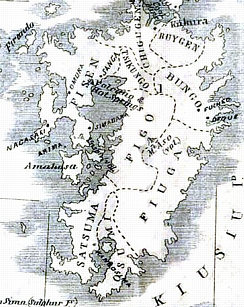Higashikokubaru's Satsuma connection: threat or menace?

Remember when Miyazaki governor HIGASHIKOKUBARU "Sonomanma Higashi" Hideo rode his Miyazaki-dialect catchphrase [Miyazaki o] dogenka sen to ikan ("We have to do something [about Miyazaki]") all the way to electoral victory and it was subsequently voted one of the top 60 Japanese buzzwords of 2006?
He's now come under attack on the grounds that his Miyazaki-ben is not the right kind: in Miyazaki City, the claim goes, folks say donge, not dogen. Rioting in the streets is surely but hours away.
Here's what's really sad, though -- I've been following this story since last year, enjoying threads like these in which correspondents from all over Japan take the opportunity to promote their own dialects. Now it all comes to a head with a semi-official statement from somebody in Higashikokubaru's publicity department:
I live in Miyazaki City too, and you're right, donge is more common. But Miyazaki is a big prefecture and dialect varies by region. Dogen is common in the southern part of the prefecture (where Governor Higashikokubaru is from) and in Kobayashi, near Satsuma in Kagoshima prefecture. Anyway, since dogen is a dialect term used within the prefecture, [dogenka sen to ikan] is in no way "unsuitable as a phrase for representing the prefecture" (県を代表する言葉として不適切).
So, it's like this. Miyazaki prefecture corresponds to the old Hyūga province, and Hyūga province had been divided de facto for almost one thousand years before the Meiji restoration made it a prefecture. Hyūga's northern and central regions have a slightly complicated history, but the Shimazu clan's control over the southwestern part was stable, and it eventually ended up part of the Satsuma Domain, and stayed that way until the restoration.
That is the short explanation of why they sound like Kagoshimans in southern Miyazaki. You could conclude from this either that dogen is just alien Kagoshima-ben that stayed behind to fester in Miyazaki prefecture after the Meiji restoration cut it off from the homeland, or that dogen is proof that modern Miyazaki prefecture boasts colorful diversity and a rich history. Higashikokubaru's office has chosen option (B), and good for them. (European states have gone to war over less.)
Another interesting fact about the northern-Miyazaki dialect (also known as Hyūga-ben): their standard verb form derives from Old Japanese's rentai conjugation. So where standard Japanese says okiru (起きる), they say okuru (起くる); instead of shinu (死ぬ), they say shinuru (死ぬる). In English, this would be like using -eth and -est verb endings. I'm all for it.
![[No-sword]](http://no-sword.jp/images/site/no-sword_banner.jpg)



language hat:
You might point out that Hyūga is represented by "Fiuga" on the antique map, a fact that may not be immediately obvious to, you know, foi polloi.